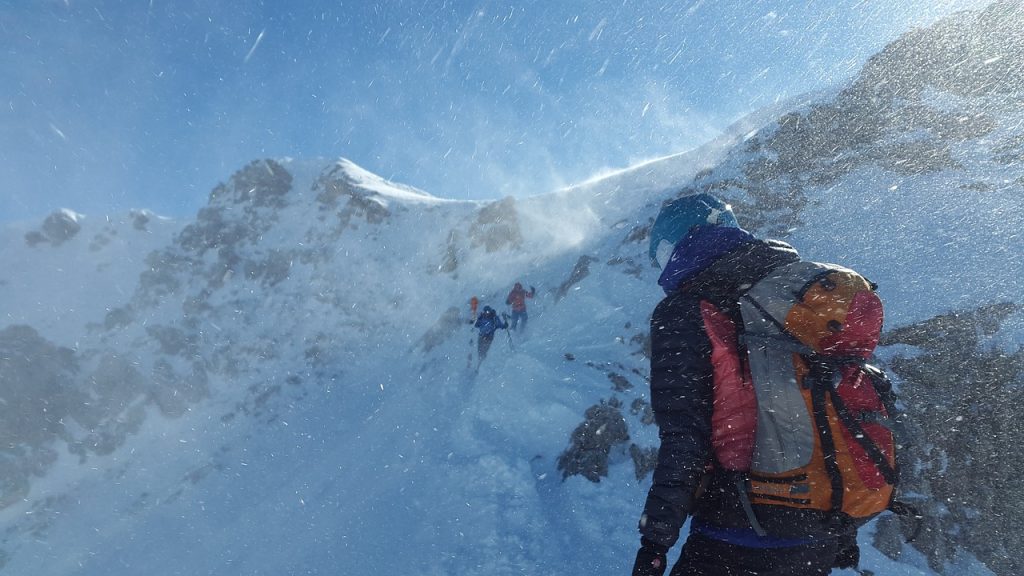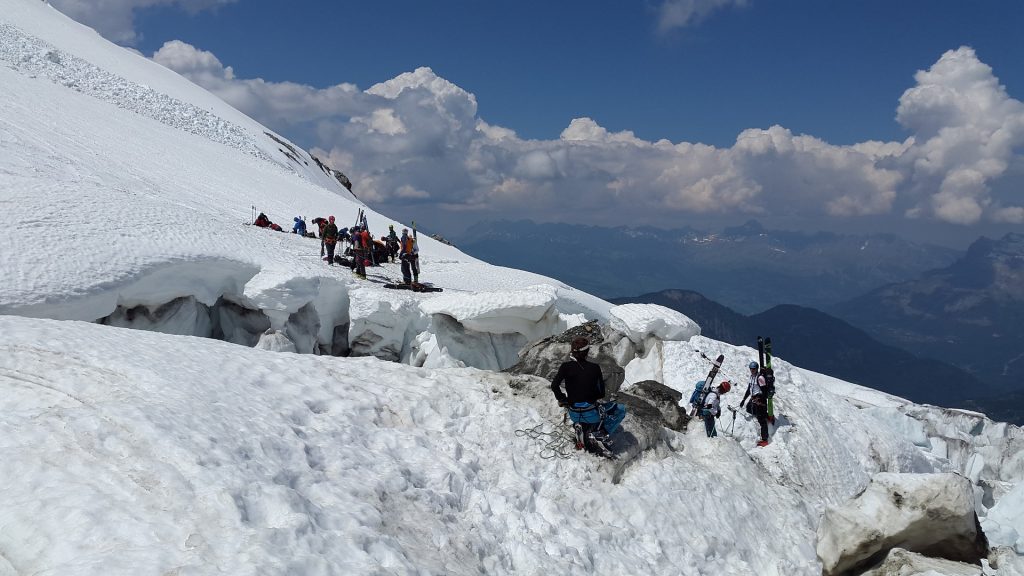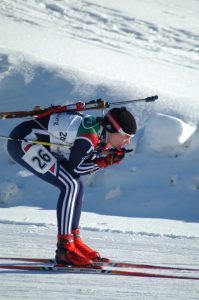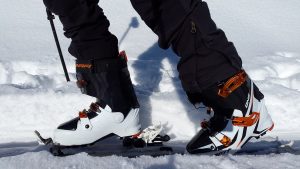What do you need to be a good mountain skier?

Let’s ski!, the winter is here. But beyond the passion, to be a good mountain skier it’s important that you strengthen your athletic profile and dispose the right equipment.
And as we know how difficult is skiing in a snow covered mountain and how demanding this sport is, we want to give you some tips to improve your skiing.
Assuming the challenge
Your good knowledge about the winter mountain’s characteristics is the most important thing before ascending. The risks of climbing can’t take you by surprise.
The mountain ski is a sport played on a not too controlled environment,, excepting in the competitions, where there are marks drawn to guide the one who goes in the first place. That’s why your knowledge and your reflexes are your best allies to face the temperature changes and detect the fissures on the snow. You must always appeal to the prudence and the common sense.

As in any sport discipline, you, as a mountain skier, have to keep a daily training with your trainer. You have to overcome yourself in the physical and mental conditions demanded by the snow descent and differents slopes, wearing the mountain skis. You, also, has to know that a mountain ski advantage is that this sport doesn’t impacts the joints, so you shouldn’t be afraid of injure yourself for training several hours.
In we talk about your daily training, this should be based mainly in those exercises that increase your aerobic and anaerobic endurance. While in the months that you’re not on the snow, you can do long trainings to strengthen the muscles, chiefly the legs, gaining power and strength for when you compete.
You must learn the mountain ski techniques, whose bases are in the alpine ski, where you learn how to descend on steep slopes and at higher speed. This technique is similar to the running mechanic, always working by muscular groups.
When you already trained the mountain ski techniques, you’ll be ready for the intensity, but this isn’t learned in less than a year.
Another aspect to ponder is the altitude sickness. If you can, spend several weeks training in a new altitude. This strategy will let you naturalize to the height in a slow way, thus reducing the risk of suffering from altitude sickness. Before a competition, try to arrive a few days in advance to help your body in this process.
Mountain ski destinations
Spain has nice mountains for training in winter time. The Pyrenees usually are the chosen winter ski mountains for being the most extensive ones (up to 137 Km), but the nature is huge and there are also several ski resorts throughout Europe in November, which is when they are snow covered.
Some european destinations to take into account are Zermatt (Switzerland), Val d’Isère (France), Saas Fee (Switzerland), Serfaus-Fiss-Ladis (Austria), Chamonix (France), Val Gardena (Italy), Ischgl (Austria), Val-Thorens (France), St. anton am Arlberg (Austria) and Aletsch-Arena (Switzerland).
A winning vision

If your goal is contest for the firsts places in mountain ski worldwide championships, you need to carve yourself out in the national competitions as the Spain’s Cup and the Spain’s Championship, whose sports events give you points and the individual classification, although it’s played by couple.
For the national competitions, don’t forget to check the mountain ski competitions from the Spanish Mountain and Climbing Sport Federation’s calendar. And don’t forget to keep up with the action of the European Cup and the World Cup that are celebrated each year.
Moreover, The European Championship and the World Championship are the most important competitions into the mountain ski international competitions’ calendar and they’re celebrated each two years in an alternative way.
If you show yourself up in these competitions it will make you better in the expositions and increase your abilities.
Winning races and scores will allow you to earn money as a professional mountain skier. And if not, as a professional mountain ski trainer or as an instructor in a ski resort you’ll be able to work on what you’re passionate about and also get paid for it.
Essential equipment
 Being a good skier involves, besides the practice, having the essential equipment, and, obviously, good skis, specially designed for this type of sport.
Being a good skier involves, besides the practice, having the essential equipment, and, obviously, good skis, specially designed for this type of sport.
The mountain skis are similar to those of alpine ski, but they are shorter and lighter and with a higher spatula to work well on different types of snow.
To climb the slopes, these skis must have glued a special tissue on its base, called sealskin, that allows one-way sliding during the ascent, preventing that the skis don’t slide down on the climbs. To give a periodic maintenance to the skis and avoid the sticked snow on the sealskin, it’s recommended to put wax liquid or hot.
The ski poles must have special washers that you can change them depending of the type of snow to ski. Among the best brands of ski poles, choose the ones that have a grip adapted to your hands, and with tips made of steel (strong material that holds more pressure).
And because your feet support the body’s full weight and you can’t take the risk of being mistreated, you must use a mountain ski boots that grab well the foot and the ankles. The best ones will be those that have higher frontal elasticity, despite the fact of being made in hard plastic; its lightness is essential to facilitate the climb. It’s also important to have ones with removable internal padded booty to dry them without difficulty.
 When the ascends are very inclined and you can’t climb up wearing the skis, or when the snow is icy, attaching the crampons to the boots will help you a lot, but in this case you must carry the skis in your backpack.
When the ascends are very inclined and you can’t climb up wearing the skis, or when the snow is icy, attaching the crampons to the boots will help you a lot, but in this case you must carry the skis in your backpack.
The blades are a kind of crampons that are used for the icy snow too, the only thing is that they couple among the boot and the ski (in the fixation).
The mountain ski helmet is as well an important accessory, because it protects the head from the falls, the rain, the snow, the stones and the cold. Another gear to have is a mountain ski backpack. It must be a light one, easy to pack the security kit and spacious for the warm clothing, the food and the sunscreen cream, among others accessories like de GPS, the compass, an altimeter, maps, a utility knife (with a flat and fluted screwdriver) and a scraper, that is going to serve you to get the snow out of the skis and the boot sole.
The mountain ski security kit is essential. It´s made by a shovel and a probe (in case that you train out of a ski resort), besides a device attached to the skier body that release signals if the skier get buried in the snow because of a spate. This device is called ARVA, by its name in french (Appareil de Recherche de Victimes d’Avalanches).
The ski clothes and gloves must be waterproof, and ones that keep the body heat. Likewise, you must always protect your eyes with glasses, no matter if there’s sun or not.
And even if you’re a professional mountain skier, you should protect your ears, nose, scalp and lips from the ultraviolet rays and the sun burns using a +50 FPS sunscreen cream.
Finally, we recommend you to prefer caloric food and easy to pack up; of course, a chocolate bar tops the list because it provides energy and its cocoa is rich in magnesium, ideal for the proper muscles functioning. Besides, the water is essential to hydrate, or also an isotonic drink. You could also add bananas and nuts, sources of potassium and magnesium.
Shipping skis
You don’t to suffer anymore if your skis are split or lost on the way. With TransSport you have a secure and specialized service to send your skis to Europe (countries of the European Union, Norway and Switzerland), with shipping box, competitive prices and insurance included; for beginners and sports professionals.
You just have to follow three steps:
![]() Fill out the online budget form indicating the material you need to send.
Fill out the online budget form indicating the material you need to send.
![]() Once the budget is approved, we will send you a special packing box, and then pick it up where you tell as.
Once the budget is approved, we will send you a special packing box, and then pick it up where you tell as.
![]() It will arrive in maximum 5 days if the transfer is abroad and in a maximum of 2 days if it is national.
It will arrive in maximum 5 days if the transfer is abroad and in a maximum of 2 days if it is national.



